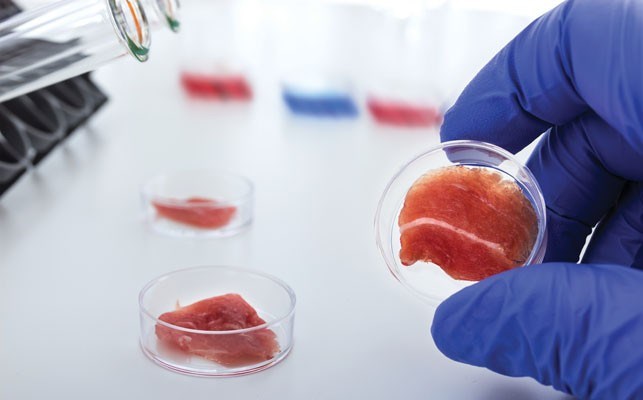I confess: I'm a lousy vegetarian.
My mom once confessed, too. She told me years after the fact that the only time I rigorously followed a vegetarian diet — this in Hawaii, the magical land of mangoes, papayas and avocadoes falling from the sky for free, although we ate lots of soybeans, too — I looked the absolute worst she'd ever seen me. And believe me, she's seen me looking bad.
I applaud, loudly, people willing and able to nourish themselves without meat. But my experience of meatlessness left me looking and, worse, feeling like a waif.
I don't take this failure lightly, especially as scientific evidence mounts about the toll the raising of animals to eat takes on our planet, our health, and the animals themselves. According to the UN about 60 billion farm animals are now used for food production every year. By 2050, when we expect to have 40 per cent more people around than we do today, the UN's Food and Agriculture Organization estimates we're going to need about double the number of farm animals for food — some 120 billion.
Where on Earth are we going to put all that cow and chicken shit? Enter "clean meat."
Now this is a term I've used for years. In my own vernacular, though, it means meat that's been raised with a conscience and without antibiotics and feedlots. You know, the kind of meat raised "cleanly," healthily, ethically with good consideration of the animals by named, small-scale producers like Pemberton Meadows Beef. Meat you're proud to take home to your kids.
So I must say I was amazed when I read that celebrity business tycoons like Richard Branson, Bill Gates and more are investing in "clean meat." Great, I thought. More clean meat for me to look forward to in the meat department. Then I read more and my eyes bugged out.
Turns out "clean meat" in this context is what's been known variously for years as vat meat, lab-grown meat, in vitro meat, cultured meat or synthetic meat — take your pick. Ahem. It's all part of what's now known as "cellular agriculture" — essentially, applying the same engineering techniques used in regenerative medicine, which is dedicated to tissue engineering for purposes like healing tissues or organs, or growing organs themselves.
Winston Churchill, always ahead of his time, referred to the idea of "cultured meat" back in 1931, ironically round about the time Hitler and the Nazis were playing with eugenics.
"We shall escape the absurdity of growing a whole chicken in order to eat the breast or wing, by growing these parts separately under a suitable medium," said Churchill. Something along the idea that today's "clean meat" people are counting on.
All this is nothing new. Cultivating muscular fibres was first done in the early '70s, but it wasn't until 2013 that the public first sat up and took notice of it all in when a Dutch pharmacologist at Maastrict University cooked and ate a cultured beef patty before the press. Mmmm, good.
But, as usual, artists have been ahead of the cultured-meat game.
In 2003, Oron Catts, the director of SymbioticA, and Ionat Zurr of the Tissue Culture and Art Project and Harvard Medical School, exhibited a "steak" grown from frog stem cells. Then they cooked and ate it.
My first encounter with the idea of culturing tissue (read: meat) by growing cells on a scaffold was at Emily Carr University of Art and Design where one of my courses was all about life-science artists, also known as bioartists — artists who work with all kinds of living materials from food and mould to their own bodies to comment on social and scientific issues arising from anything "bio."
One of the most well-known collectives working around bioart is SymbioticA, which is based at the University of Western Australia in Perth. Back in 2000, they used the same technology used to "grow" artificial organs in culture to create The Worry Dolls — little semi-living, tissue-engineered sculptures based on the worry dolls given to children in Guatemala to soothe their worries and fears. Only in this case, the artists are trying to point out fears, not assuage them (https://dublin.sciencegallery.com/visceral/semi-living-worry-dolls/).
SymbioticA made seven small dolls using biodegradable polymers and adding muscle, endothelial and osteoblast cells to express fears arising around eugenics, biotechnology and capitalism. Ironically, this last category is at least partly fuelling the current interest in "clean meat."
Pundits say that the best way to think of the meat culturing being done now, is to think less of petri dishes, and more along the lines of "meat breweries." Kind of gives a whole new meaning to the idea of craft beer.
Brewed or not, we'll have to wait and see just how far this new "clean meat" will go. Of course, the folks at the Good Food Institute, the non-profit organization "powered by philanthropy," which is behind the clean meat initiative known as Memphis Meats that Branson, Gates et al are investing in, are all gung ho. But scientists like Margaret Mellon at the Union of Concerned Scientists in the U.S. thinks that the energy and fossil fuel needed for large-scale meat culture could be more harmful to the environment than producing meat the traditional ways.
Even reluctant vegetarians like me can see the pros of "clean meat," but for now I think I'll be sticking to my more traditional interpretation of the term.
Glenda Bartosh is an award-winning journalist who still enjoys a nicely roasted "clean" chicken.




